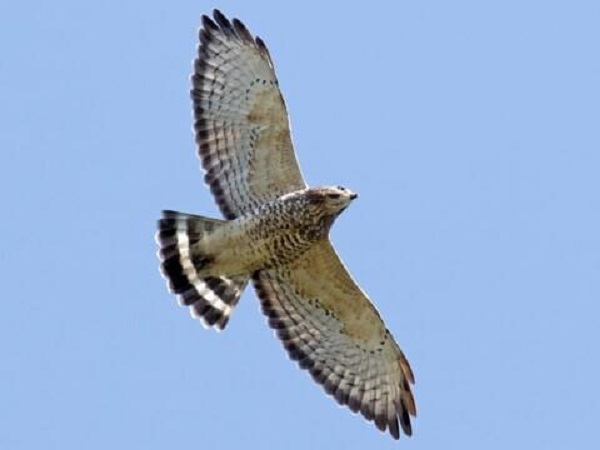
The Broad-winged Hawk (Buteo platypterus) is a medium-sized hawk that belongs to the family Accipitridae. They are found throughout North and South America and are known for their broad, rounded wings and relatively short tails.
Adult Broad-winged Hawks have brownish-black feathers on their backs, with rusty-brown or reddish-brown bars on their tails and wings. They have a distinctive white band on their tails and white underparts with brown streaks. Juvenile Broad-winged Hawks have similar plumage but are more mottled and have less distinct bars.
Broad-winged Hawks are known for their unique behavior of migrating in large flocks known as “kettles” during the fall migration. They are also skilled hunters, feeding on small mammals, birds, reptiles, and insects.
How Broad-Winged Hawks Help the Environment
Broad-winged hawks play an important role in their ecosystem by helping to control populations of small mammals, birds, reptiles, and insects. As predators, they help to keep the populations of these species in balance, which can prevent overgrazing or overpopulation of certain species.
In addition to their role as predators, broad-winged hawks are also indicators of ecosystem health. As a top predator in their habitat, they can serve as an indicator species for overall ecosystem health. If the population of broad-winged hawks declines, it could indicate that there are issues with the health of their habitat or with the populations of their prey species.
Furthermore, because they are migratory, broad-winged hawks can help to spread seeds and nutrients across different habitats as they travel, which can have positive effects on plant growth and biodiversity.
Overall, the presence of broad-winged hawks in an ecosystem can have a positive impact on the health and balance of that ecosystem, making them an important species for conservation efforts.
8 Fun Facts About Broad-Winged Hawks
Broad-winged Hawks are known for their distinctive high-pitched whistle, which they use to communicate with one another during the breeding season.
During the fall migration, Broad-winged Hawks can form flocks of thousands of birds, known as “kettles”, as they ride thermal currents to migrate south.
Unlike some other raptors, Broad-winged Hawks do not build their own nests. Instead, they often use old nests built by other species, such as crows or squirrels.
Broad-winged Hawks have been known to use a variety of hunting techniques, including hovering in place over potential prey and even catching insects in mid-air.
Although they are relatively common, Broad-winged Hawks can be difficult to spot because they tend to stay hidden in the forest canopy.
Broad-winged Hawks are monogamous, meaning they mate with only one partner during the breeding season.
The scientific name for the Broad-winged Hawk, “Buteo platypterus”, comes from the Greek words “buteo” meaning “buzzard” and “platypterus” meaning “broad-winged”.
Broad-winged Hawks can tolerate a wide range of habitats, from dense forests to open fields, which makes them one of the most adaptable species of hawks.
Related Articles & Free Email Newsletter Sign Up
Are Seeds or Pellets Better for a Bird?
Guinea Fowl Offer Pest Control and Can Be a Watch Dog
The Once Nearly Extinct North American Beaver is Now Thriving


Comment here